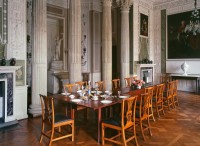Das Gemälde zeigt Albertine Agnes von Nassau-Diez, geb. Prinzessin v. Nassau-Oranien (1634-1696) im Dreiviertelbildnis in einem halbrunden Fensterahmen sitzend mit Ausblick auf eine hüglige Landschaft. Entsprechend der Melancholia-Symbolik hat sie den Kopf in den linken Arm gestützt. Der Fensterrahmen ist von einem ovalen Kranz von Blüten umgeben (wohl von Adrian de Lust gemalt). Über dem Torbogen erscheint ein Totenkopf als Vanitas-Symbol. Das Bild ist Teil einer Serie von gleichartigen Bildnissen der 1665 noch lebenden drei Töchter des Statthalters Friedrich Heinrich v. Oranien, die nach dem Tod der vierten Schwester, Luise Henriette v. Brandenburg entstand.
Leihgabe des Landes Sachsen-Anhalt (KSDW)
en

